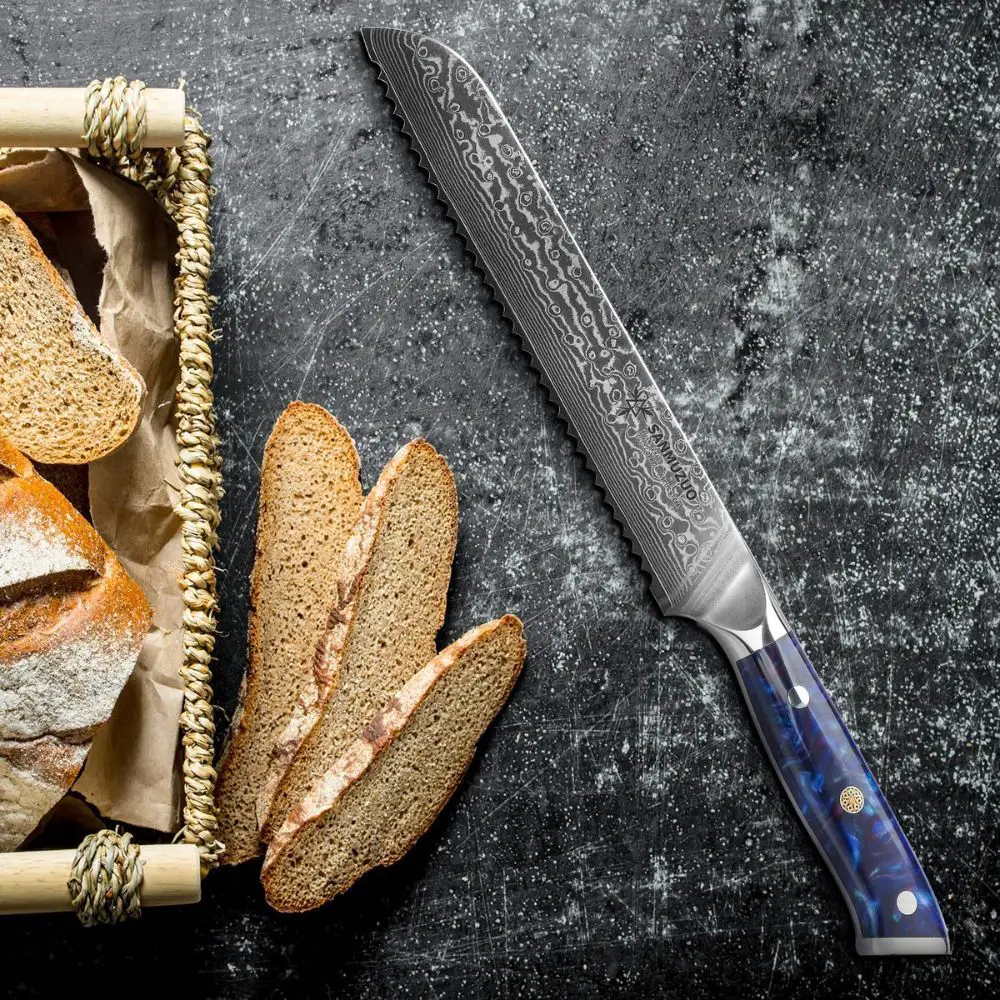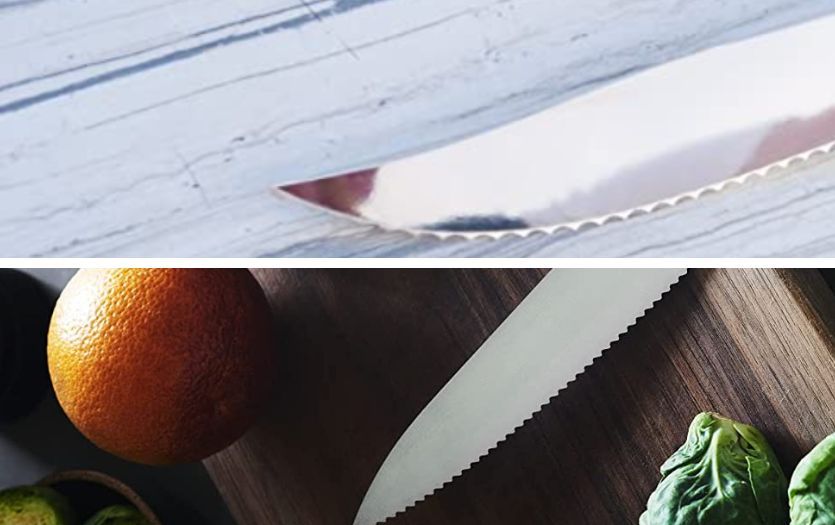Mastering the Art of Sharpening: Know How to Sharpen a Serrated Knife
Learn the expert techniques for mastering the art of sharpening and keep your serrated knives razor-sharp with our in-depth guide. Discover the best tools and methods for achieving a precision edge
Are you tired of struggling with your dull serrated knife? Sharpening a serrated knife can seem daunting, but it doesn't have to be.
In this guide, we'll walk you through the steps to keep your serrated knives razor-sharp and ready for any task.
From selecting the right tools to understanding the proper angle for sharpening, you'll be slicing and dicing like a pro in no time.
So, if you want to make your cutting tasks easier and more enjoyable, keep reading and learn how to sharpen your serrated knives like a pro!
What is a Serrated Knife and What are they Used for

A serrated knife, also known as a bread knife, is a type of knife that features a saw-like edge made up of a series of small teeth. These teeth or serrations, help the knife to grip and saw through tough and uneven surfaces, making it perfect for cutting through hard crusts of bread and cutting through meats. The serrated edge is particularly useful for slicing through anything that has a tough exterior and a soft interior.
Serrated knives are also great for sawing through meats with bones and cutting through rope or other materials. The serration creates a longer cutting surface and also distributes the cutting force along the edge. This helps serrated edges to maintain their edge sharpness longer than a straight-edge knife.
Because of their versatility and cutting prowess, serrated knives are also ideal for outdoor activities such as hunting and camping, as they can easily be used to cut through rope, canvas, and other tough materials.
Serrated knives act like hand saws and can be used to cut through small branches, net lines, or other tough items. These knives are known for their raw power and are not suitable for bush crafting or anything that requires finesse.
Overview of How to Sharpen a Serrated Knife
Sharpening a serrated knife requires a bit more finesse than sharpening a regular straight-edge knife, because of the serrations on the blade but it's far from impossible.
With the right tools and technique, you can easily sharpen your own serrated knives in no time. The key is to understand how serrations work and how best to sharpen them without damaging their unique cutting edge.
The serrations on the blade are also smaller and harder to access, which makes it more difficult to sharpen the whole edge evenly. Additionally, the angle at which the serrations are ground can affect the sharpness and function of the knife, so it's important to maintain the correct angle when sharpening.
It's also important to note that the serrated edge is not meant to be sharpened in the same way as a straight edge, it's not about getting a razor-sharp edge, but about maintaining the teeth of the serrations.
A sharpening steel or honing rod is not ideal to sharpen serrated knives as it will make the edge duller instead of sharper if you are using the techniques of sharpening a straight-edge knife.
To get started, you'll need to select the right sharpening tool for your needs. Serrated knives require different types of sharpening stones or steels that are specifically designed for their saw-like edges. You may also want to consider investing in an electric sharpener as they make short work of most blades with minimal effort on your part.
Once you have all the necessary tools at hand, it’s simply a matter of understanding how much pressure should be applied when honing each individual tooth along the blade’s edge. It’s important not to apply too much pressure as this could damage or even blunt the teeth entirely!
With practice, patience, and attention to detail, however, anyone can learn how to properly sharpen any type of serrated knife quickly and efficiently!
Understanding the correct angle for sharpening a serrated knife

When sharpening a serrated knife, it's essential to understand the correct angle for each tooth of the serrated edge. The angle of the tooth affects the sharpness and effectiveness of the serrated edge, and if not done correctly, the serrations can become dull or uneven. The angle of the tooth can also vary depending on the design of the knife and the intended use.
For most serrated knives, the angle of the tooth should be around 20-30 degrees. However, it's important to check the manufacturer's instructions or consult a professional to ensure the correct angle for your specific knife.
To sharpen at the correct angle, it's recommended to use a serrated knife sharpener with adjustable angle guides or to use a stone at the recommended angle.
Additionally, it's important to sharpen each tooth individually and not to sharpen the entire serration at once, as this can cause damage to the serration. It can be a time-consuming process but the end result is worth it.
Step-by-step guide on how to sharpen your serrated knives like a pro
Sharpening serrated knives can be tricky, but with the right tools and techniques, you can easily sharpen them like a pro. Here's a step-by-step guide to help you out:
- Start by selecting the right sharpening tool for your serrated knives. A serrated knife sharpener or a diamond sharpening rod works best.
- Secure the knife in a vice or clamp to hold it steady while sharpening.
- Identify the dull serrated teeth on the knife and place the sharpening tool on the first serration. Make sure that the rod matches the serrations on your blade.
- Using a back-and-forth motion, sharpen each tooth individually, making sure to hold the sharpening tool at the same angle as the serration. This can be tedious and you have to make sure to run through each gullet sharpening from the inside out to remove all the burrs.
- Repeat this process for all the serrations on the knife, working your way from the base of the knife to the tip.
- Once you have sharpened all the serrations, use a honing steel to realign the edge of the knife.
If you don't possess a diamond sharpening rod, fear not! You can still sharpen your blade with a stone - it'll simply take extra effort. You have to select the edge and grit of the stone depending on the condition of your blade. Then match the edge of the stone with the teeth of your blade.
After you have finished setting the angle, simply hone it like a knife with the sharpening rod - gliding from one edge to another steadily along its bevel.
Discover the top rope saws to cut through any material!
Tips and tricks for keeping your serrated knives in top condition
One of the keys to keeping your serrated knives in top condition is to make sure they stay sharp. Here are some tips and tricks for keeping your serrated knives in top condition:
- Use high-quality knives that require low maintenance.
- It is important to have your knives sharp, but regularly sharpening your serrated knives can damage the serrations. So use your stones and rods judicially, and remember due to their unique shape, they will cut better than a straight knife even when they are dull.
- Use a honing steel to realign the edge of the knife. This will help to keep the edge and improve the overall sharpness of the knife.
- Store them properly in a safe place, such as a knife block or sheath. This will protect the knives from damage and also keep them easily accessible for use.
- Don't use them for the wrong task like prying open cans or cutting hard materials. This can damage the serrated knives and lessen their effectiveness.
- Cleaning and caring for your serrated knives are an essential part of keeping them in top condition. Make sure to clean them after each use with warm water and a mild detergent, then dry them with a soft cloth before storing them away to prevent rust and corrosion.
- Avoid dropping them: Dropping a knife can cause damage to the blade or handle, so be careful when handling them.
- Never put your serrated knives in the dishwasher; instead, hand-wash them carefully and avoid exposing them to extremes of temperature.
By following these tips and tricks, you can ensure that your serrated knives stay in top condition and continue to perform well for many years to come.
Final Words
Mastering the art of sharpening a serrated knife may seem challenging, but with the right tools and techniques, it's a skill that can be easily acquired.
Whether you choose to use a sharpening stone or a specialized serrated knife sharpener, regular maintenance is crucial to keeping your serrated knives in top condition. Remember to follow our tips and tricks for keeping your serrated knives in top shape, and always store them properly.
And if you're a hunting enthusiast, you'll want to check out our article on the best hunting knife sharpeners. These specialized sharpeners will help you keep your hunting knives in top condition, ensuring they are always ready for your next hunting trip.
Don't miss out on this valuable resource, and make sure to check it out today!


